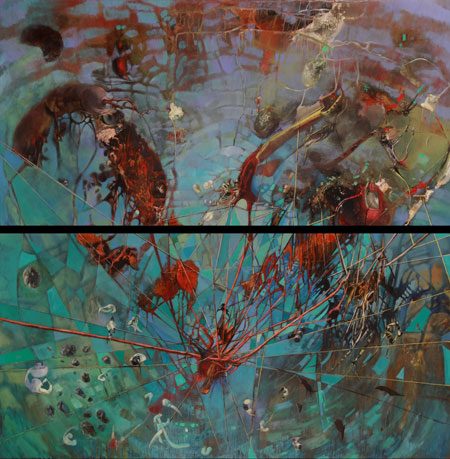
Last month, the Visual Art Source ran the first part of an essay about what Mihaly Csikzentmihalyi calls the “flow,” the state of total concentration — indeed, total absorption — in creative activity. Fascinated by his ideas, I decided to speak to a few contemporary artists and see how they feel about the flow.
I visited painter/photographer Fatemeh Burnes, whose work was recently exhibited at The George Gallery in Laguna Beach and the Sturt Haaga Gallery in Descanso Gardens. Burnes weaves woodcarving into the usually two-dimensional medium of painting, so her rich surfaces both depict and embody texture. She refers to Csikzentmihalyi’s flow experience as the “zone.”
“Sometimes I can’t get out of the zone! After I go through my rituals — I used to have to have everything in a certain way in the studio, but lately I’ve been looser with that — and begin to work, people may try to interrupt me, but I can’t stop.
“What is it like? It generally feels like you’re somewhere between reality and dream. You’re partly conscious of what is going on, and the other part isn’t conscious at all. When I’m working, there’s no fear. It’s almost like you disappear. You become a non-matter. It goes beyond you. It’s an effort to get back into your ordinary routine.
“I have to 100 percent give myself to the work. In the past when I did illustration, I was a lot more conscious of the project based on the expectations of the client. It was like dancing with someone else. But now the way I work, I’m dancing alone. I feel selfless, weightless. It’s very free. I still feel the pain and the discipline of making things work out, but it’s very joyful. Like working in the garden, you can get cut and scratched, but you think it’s great. I am consumed by the work. It occupies me to a point that I kind of don’t exist. I feel safe and completely free.
“When I come into the studio, it’s all about rhythm, it’s playful. I’m not disciplining myself consciously. I’m working and of course I can get frustrated. But even that becomes so natural. The problem solving process is natural, it is also in the zone. I’m not racing, not trying to reach a destination. It’s like dream walking. It’s a wonderful place to be.”
When Burnes spoke about the ritual she enacts before she starts painting, I thought about how Japanese Sumi-e artists prepare their ink before painting: “Making the ink is a form of moving meditation for the painters, during which they prepare themselves mentally for the painting process.” And I began wondering how many other contemporary artists, like Burnes, have pre-painting rituals that help them move into the flow.
Photographer and sculpture Abigail Gumbiner emailed that she read about rituals used to shift artists into the creative/altered state of mind. “I realized that upon entering my studio I would first fanatically arrange my beautiful oil and water crayons in a precise order, and that would begin to focus my mind away from everything else in the world. I also used favorite music played very loudly to connect myself into myself.”
Abstract painter Craig Antrim added, “One of the things I like to do is sit with a cup of coffee and look at the studio wall, at the paintings that are done and those that are in process. That helps me get over the hump, as it were. It helps make the transition from, say teaching, to painting.”
Antrim’s comments made me realize that making a cup of tea is my ritual signal: Okay, now it’s time to focus, to write, to go there, wherever there will be for the day. And once the ritual is enacted, I move into the zone, and the words flow. It’s not automatic, and certainly not always easy, but usually the flow comes and I find (re-find?) the place of creative inspiration.
Csikzentmihalyi speaks about the many benefits of flow experiences. You feel good: the flow can produce “intense feelings of enjoyment.” He adds that flow experiences are related to personal development and growth.
But the consequences of flow experiences are not all positive. They have been shown to foster addictive behavior. I know a painter who swears he does his best work stoned. And we all know the stories of hard-drinking writers like Ernest Hemingway. There can be drawbacks as well: Some studies indicate that flow experiences can lead to stress responses, like high cortisol levels and reduced heart rate variability.
